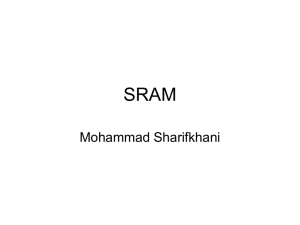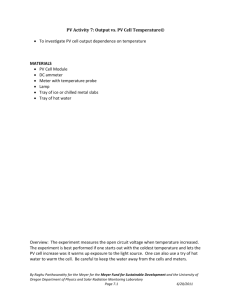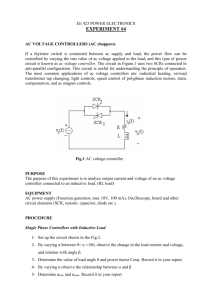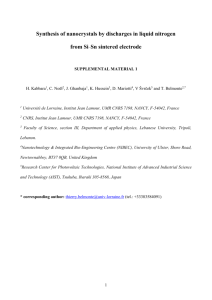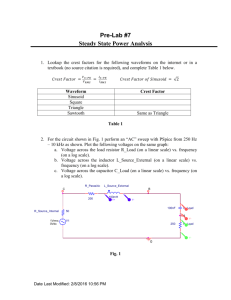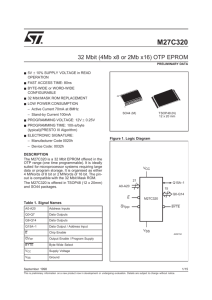1 Practical Logic Characteristics
advertisement
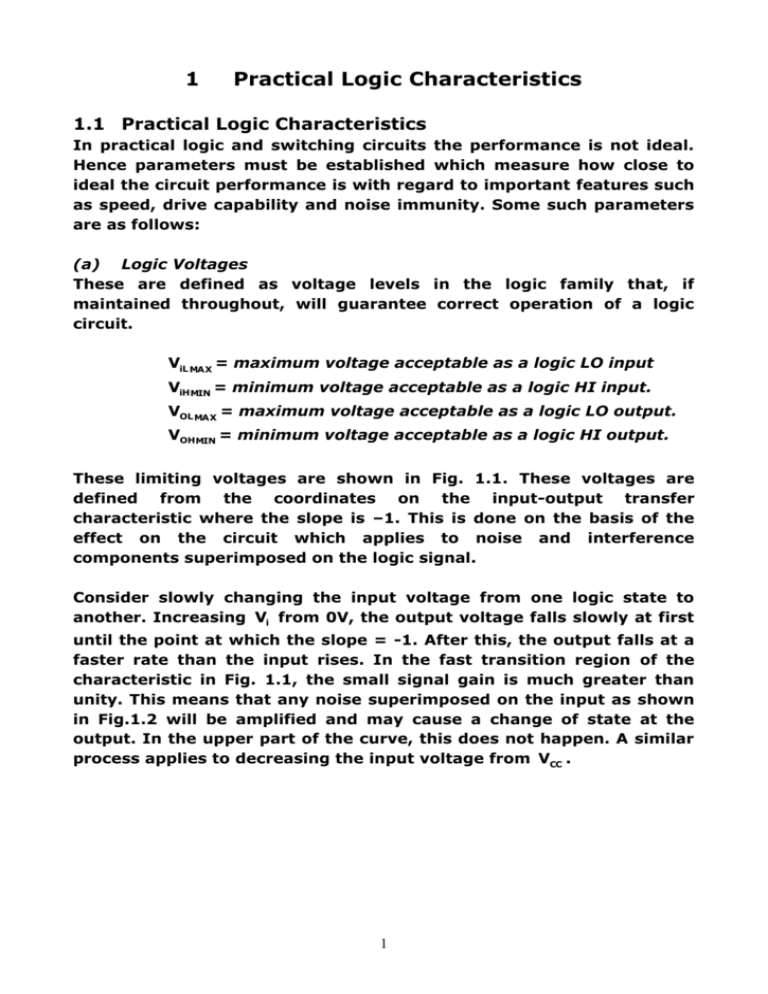
1 Practical Logic Characteristics 1.1 Practical Logic Characteristics In practical logic and switching circuits the performance is not ideal. Hence parameters must be established which measure how close to ideal the circuit performance is with regard to important features such as speed, drive capability and noise immunity. Some such parameters are as follows: (a) Logic Voltages These are defined as voltage levels in the logic family that, if maintained throughout, will guarantee correct operation of a logic circuit. ViL MAX = maximum voltage acceptable as a logic LO input ViHMIN = minimum voltage acceptable as a logic HI input. VOL MAX = maximum voltage acceptable as a logic LO output. VOHMIN = minimum voltage acceptable as a logic HI output. These limiting voltages are shown in Fig. 1.1. These voltages are defined from the coordinates on the input-output transfer characteristic where the slope is –1. This is done on the basis of the effect on the circuit which applies to noise and interference components superimposed on the logic signal. Consider slowly changing the input voltage from one logic state to another. Increasing Vi from 0V, the output voltage falls slowly at first until the point at which the slope = -1. After this, the output falls at a faster rate than the input rises. In the fast transition region of the characteristic in Fig. 1.1, the small signal gain is much greater than unity. This means that any noise superimposed on the input as shown in Fig.1.2 will be amplified and may cause a change of state at the output. In the upper part of the curve, this does not happen. A similar process applies to decreasing the input voltage from VCC . 1 VCC Input Logic Voltages Output Valid high output Valid high input VOH MIN NMH ViH MIN ViL MAX NML Valid low input VOL MAX Valid low output VO VOH MIN Tangents at slope = -1 Transfer Characteristic VOL MAX Vi ViL MAX ViH MIN VO VO Sourcing current Sinking current VOH MIN Drive Capabilities VOL MAX I OH MAX Fig. 1.1 IO Practical Static Logic Characteristic 2 I OL MAX IO VO Output noise generated Vi Fig. 1.2 VCC Noise superimposed on input Effect of Noise Superimposed on a Logic Input (b) Noise Immunity The transfer characteristic shown in Fig. 1.1 is deliberately shaped so that: ViHMIN VOHMIN and ViL MAX VOL MAX This allows a margin in the voltage levels so that an amount of noise can be superimposed on the output voltage of one gate before the logic level is misinterpreted at the input of another gate that it is driving. This can be seen in Fig. 1.3 below. Noise Margins are defined as: NMH VOHMIN ViHMIN and NML ViL MAX VOLMAX VOH MIN VIH Fig. 1.3 MIN Benefit of Allowing a Noise Margin 3 (c) Drive Capability There is a limit to the number of gates that can be connected as load to the output of a single gate which will allow correct voltage levels to be maintained. The current that the driving gate can source or sink is limited and the gate also has finite output impedance. Output voltage vs current characteristics are shown in Fig. 1.1. I IL MAX I OL MAX I OH MAX I IH MAX Figure 1.4 Input and Output Load Currents in Logic Gates With reference to Figure 1.4 Fan-out is the maximum number of similar gates that can be connected to a gate output and is defined as: F IOHMAX IiHMAX or IOL MAX IiL MAX whichever is the lowest (d) Switching Times The figures of merit used to characterize the speed of operation of logic gates are its switching times shown in Fig. 1.5. The rise and fall times are measured between the 10% and 90% points on the voltage waveform transitions at the gate output. The propagation delays are the delays resulting in a change of state taking place at the output of a gate in response to a change of state applied to one of its inputs. These are measured between the 50% points on the input and output voltage waveforms. (e) Dynamic Noise Immunity A noise spike, which temporarily brings the input voltage across a switching threshold can often be tolerated, without a consequential change of state at the output, if there is not enough energy in the pulse to cause a change of state. In general, this is the case if the duration of the spike is less than the gate propagation delay as seen in Fig. 1.5 4 Switching Times VH Vi (t) 50 50 VL t PLH t PHL VH 90 90 VO (t) 50 50 10 10 VL tF tR t PLH = propagation time for a low-to-high output transition t PHL = propagation time for a high-to-low output transition tR = 10%-to-90% rise time of output voltage tF = 90%-to-10% fall time of output voltage Dynamic Noise Performance Vi VCC Vi ViH ViL MIN MAX t t t noise t PLH t noise t PHL VO VCC VOH MIN VOL MAX t Fig. 1.5 t Practical Dynamic Logic Characteristics 5 1.2 Limitations of Single Transistor Switching Circuits (a) Finite Gain The limited gain provided by a single transistor limits the steepness of the transfer characteristic in the transition region between HI and LO output voltages. (b) Logic Voltage Dependence on Load When the transistor in the simple bipolar inverter circuit shown in Fig. 1.6 is OFF, the output Logic HI voltage is given as: VH RL VCC RL R C This is heavily dependent on R L . Clearly this situation is totally undesirable and in practice the output voltage should be as independent of the load as possible within the boundaries of operation, i.e the fan-out specification. A means must be found of better defining the output logic HI voltage. VCC RC RL RB VO Fig. 1.6 Voltage Dependence on Load of Simple Bipolar Logic Gates 6 (c) Slow Transistor Turn-Off When Vi 0V, the transistor in the simple bipolar inverter circuit of Fig. 1.7 turns OFF. To accomplish this, the overdrive charge stored in the base region in saturation must be removed. This is done by a small V discharge current in the base IB BE which makes the process quite RB slow. In addition, any load capacitance present must be charged up through the collector resistor, R C , which further delays the output transition from logic LO to logic HI. A means of removing the charge stored in the base of the transistor must be found, as well as a means of charging up load capacitance more rapidly. RC RB CL IB -ive Fig. 1.7 Speed Limitation of Simple Bipolar Logic Gates 7
